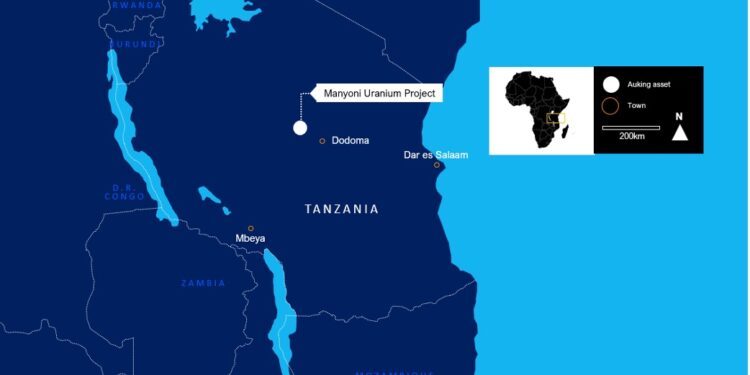AuKing Mining Limited (ASX: AKN) has started a 4,400m drilling and associated exploration programme at its Manyoni Uranium Project in central Tanzania.
AuKing’s CEO, Paul Williams, said that Manyoni had the potential to be a near-term uranium production asset for the Company and that it was pleasing to be able to commence the drilling program after ongoing rain delays.
“The drilling programme at Manyoni is intended to provide the basis for an updated resource estimate and thereby set the platform for development activities at this project. We will include some drill holes at the nearby Itigi project area where a major 40km x 10km radiometric anomaly was identified but not subjected to drilling,” said Mr Williams.
“We are also awaiting a response from the Minister of Mines in Tanzania to our appeal against the two revoked Manyoni licences and are hopeful of a positive outcome,” he said.
Manyoni Project Location
AuKing holds several granted prospecting licences (PLs) which include almost all of the Manyoni uranium resource areas previously held by Uranex NL (now called Magnis Energy Technologies Limited) (UNX). Manyoni is located approximately 100 km west of the major city of Dodoma in central Tanzania.
Manyoni had been the focus of activities of UNX from the early 2000’s up until 2013. The Fukushima disaster in 2011 had a dramatic impact on the uranium market and UNX’s apparent focus turned to graphite interests in the region.
Uranium mineralization at Manyoni is reported to occur as near surface secondary enrichment of unconsolidated Mbuga clay sediments and underlying saprolite material. The distribution of uranium is reported to be in the Mbugas and along catchment profiles indicating that uranium is anomalous in ground water for much of the length of the catchment into the Bahi depression. This presents a model for precipitation of uranium within Mbuga traps and in reduced carbonate-rich fluvial channels.
The uranium deposits discovered at Manyoni to date are shallow, generally less than 10m deep. To date several individual uranium bearing playa lakes/project areas also referred to as Mbugas have been identified through exploration activities.
The Manyoni deposit is classed in the IAEA (International Atomic Energy Agency) classification of uranium deposits as a surficial deposit. Surficial deposits typically vary in size and generally contain low grade uranium. Surficial uranium deposits were formed in the Tertiary and Recent when uranium-rich granites were deeply weathered in a semi-arid to arid climate. The uranium mineralization is often associated with fine-grained surficial sand and clay.
For further information please visit: https://www.aukingmining.com












